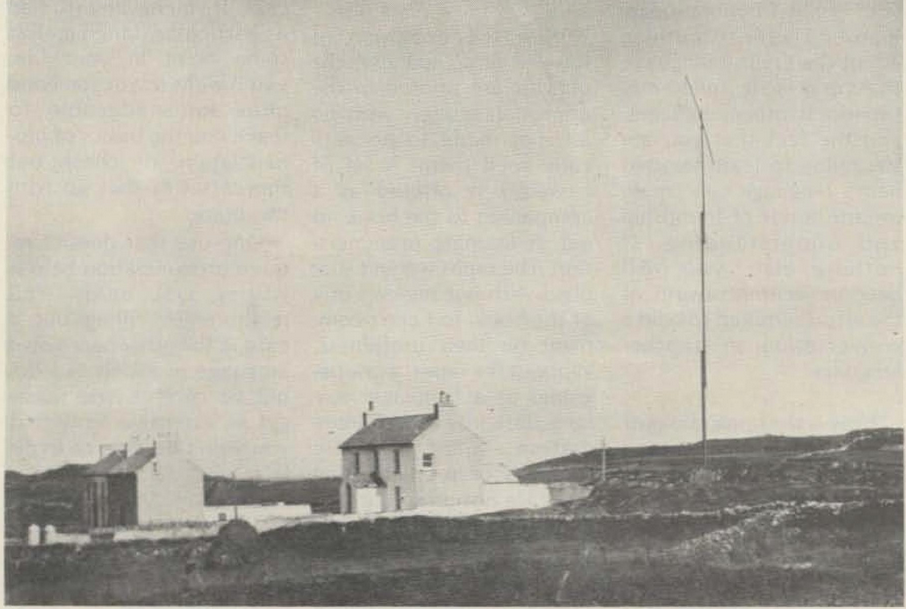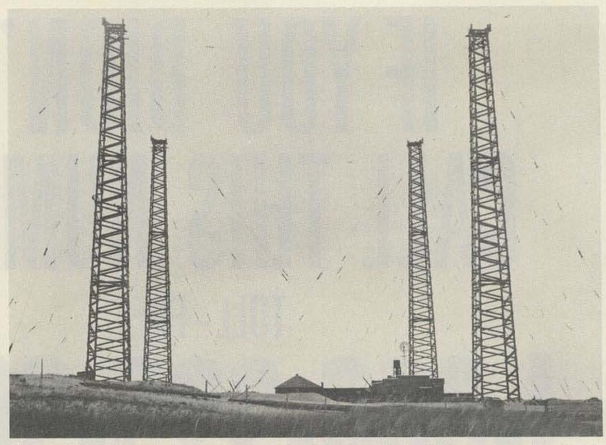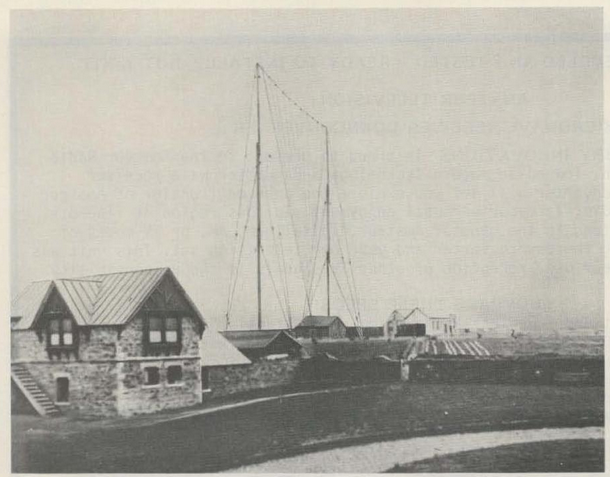Aerial Heirlooms – Towers from the past
73 Magazine July 1981 (#250 Page 66) by AK0Q Keith Greiner Iowa USA
The history of the early days of radio is well established and documented. It has been searched and researched until it is now uncommon to uncover something truly new on the subject of Marconi’s early experiments.
But history, besides being a great healer, is perhaps the greatest forgetter. In the end, only the highlights of the firs, the greatest, the most powerful, etc., finally survive the test of time. Often the fascination glimpses of working by common people and events close to the historical highlights are forgotten forever.

Likewise, only a few historical objects can be preserved. It is relatively easy to preserve a spark-gap transmitter, crystal receiver, telegraph key, or pair of headphones when compared to the monumental task of preserving the towers or antennas. But without these truly historical items, there could never be radio memorabilia. Old towers eventually rot or rust away. Fall prey to wind lightning, salty sea air, or other elements, and are finally completely lost. For example, at Poldhu, England, where the first transatlantic signals were broadcast, all that remains is a Cornish granite memorial. Hardly a trave can be found of the famous towers which graced the spot for 33 years. For this type of historical object, we must rely on photographs, if there are any, and written records about them.
Recently, I rediscovered a tape recording that combined the rare personal insights of one who worked on early Marconi projects with some almost forgotten details about Marconi’s early tower construction. The tape was made by a man who helped construct some of the early towers used by Marconi.
The rare personal glimpse is from a speech made by Reverend Wilfred Wallis, speaking in February 1956. My father, Loren Greiner W0GTW, had the foresight to tape the brief speech. Now, with the help of o Mrs. B. Hance, the Marconi Company Historian, I have been able to corroborate part of the facts given by Reverend Wallis (who died in 1973 after serving the United Methodist Church in Pawnee City, Nebraska, for 20 years) and add some fascinating details about these early towers.
After the first transatlantic transmission and Marconi’s diligently objective diary notation that “ sigs were heard at 12:30, 1:10, and 2:20 on December 12, 1901, “ the growth of radio communications took a giant leap. The discovery that radio signals could travel long distances was literally the light at the end of an eons-log tunnel of isolation for ships who out of touch with the world for the duration of their voyages.
Immediately, experiments were begun to improve receiver sensitivity and study propagation to find a way to improve on the reliability of transmissions. About this time, other transmitting and receiving stations were installed by Marconi and others. Finally, on June 4, 1903, the silence barrier for ships was truly broken when the prestigious Cunard ship line began a series of onboard daily newspapers called the Cunard Bulletin to help travellers keep in touch with the rest of the world.

About this time, Reverend Wallis contributed, in a small way, to the development of radio communication. Here, in his own words, is the story of his involvement.
“I was an apprentice in the shipbuilding yard. I was in what was called the mask-making department. They moved the apprentices from one department to another, every six months, to learn this phase of the shipbuilding, then some other, and so on. At each stage, you would have an instructor for that department.
“So, I was in the mast department, and word came one day that we were to build three sets of a mast in two parts – what they called a lower mast and a topmast: One fits into the other. As I remember, they were to be 180 feet long. We would take pine trees that they would keep in the yard all the time, and then cut them down and make them round to make a straight mast.
“Ordinarily, in those days, most of our masts were steel, but we also made wooden mast for some of the smaller ships and some of the boats. So, we had the order for these sets of masts, and everything was sort of secretive. We didn’t know a great deal about it, although my instructor was one of the men who had a great deal to do with it. He was in charge of the work on them. They were to be set up at one harbour, the long harbour. In fact, it was large enough to house all the British ships. There was always a number of ships there. There they could come out the open part of the harbour, what they call the Land’s End. That was the first station to be built in this particular series. The second station using the next pair of masts was to be at Scilly Isle; the third was to be at Roche’s point in Ireland.

“So, the masts were finally finished and all the fittings put on them, and being an apprentice, I had the disappointment of my life. The instructor got to go over to Ireland to set up the mast there and another man was sent to the other places. When I tried to go, they said ‘No! Apprentices are not allowed to go out of the country’”
Although the masts constructed by Reverend Wallis were made of two parts, many early towers were made of masts from three poles, as shown in Photo A. Each Pole had its own set of guy wires. It seems only fitting that service so relative to ships at sea should have its early towers made of those ships’ masts erected on the land.
Being an apprentice, Reverend Wallis’ view of the operation was no doubt tempered by his position, and the fact, as he noted, that the whole operation was somewhat secretive Records from the Marconi Company shed light on a few of the problems of building radio towers from ships’ masts.
Comments by E.A.N. Pochin, a Marconi assistant have been preserved in the Marconi Company archives. They indicate that one of the major problems was that all of England did not have enough large logs to make some proposed towers, and the designers were faced with project delays of two months if they chose to wait for larger logs to be imported from the United States. As Pochin wrote in July 1901, less than six months before the first transatlantic transmission:
“I made it perfectly clear to Messers Blythe and Pascoe that the logs must be sound, and insisted on their quotation specifying the fact of the timber being for mast work to prevent their pleading ignorance.” (This sounds like most any purchasing agent making sure he’s covered in the event the vendor doesn’t deliver the goods.)
In any event, the work on the mast was to continue on the assurance from the builders’ chief carpenter that the best available logs would “work up perfectly clean.” Final approval, however, rested with Marconi.
Even as the first signals were crossing the Atlantic, plans were being drawn up for replacement towers at Poldhu transmitting station. Specifications dated December 9, 1901, called for four-sided towers like those shown in the often Published photographs of the Glace Bay, Nova Scotia station.
When finally erected, these towers must have been an impressive sight. The four wooden towers were to be placed in a square, with 210 feet to aside. They were to be 215 feet tall, with three and a half feet of that height buried in a concrete foundation. Each tower was a gigantic twenty-one and a half feet square at the top.
In today’s world, we would think the wooden construction would be standard materials like 2x4s or perhaps 2x12s. Not so Records indicate the tower legs were made of boards fixed 11’x3’x12’. Four planks were arranged together as shown in Fig. 1. Zigzag braces were made of 9”x3” wood and bolt head and nut. For extra strength, they had diagonal tie bolts every seven and a half feet.

In order to brace the towers against the possibility of 92-mph winds at Poldhu, the four towers were each guyed with ten wires called “stays.” The guys were to be connected at the top of each tower and the middle, rather than below the top as with typical modern construction. Guy wires were of 13/16” steel wire with a breaking strength of 18 tons. Upper guy wires were to have two insulators, while lower guys were to have the only insulator.
In today’s world, where every broadcast tower used high-quality porcelain insulators, it is hard to imagine how radio pioneers might have improvised their insulators. The answer lies in the details of the stay in Fig 1. Marconi’s specification calls for “elm deadeye spliced in …connected by means of 3” circumference hemp rope lanyard, having a breaking strain of 2.5 tons in a single length of a total of 15 tons in the six parts”
The entire guy wire, including insulators, was to be covered with “two good coats of Stockholm tar.” Finally, each tower was to be painted with two or three coats of paint, with no specific colour specified.
In the years after Reverend Wallis participated in the construction of Marconi’s pole towers, I know he felt proud to have been a small part of such tremendous events which contributed to great safety on the seas and better communication between continents. In the same way, the other men and women who participated in unknown but important ways to the building of other Marconi and equipment must have known of the importance of their work to these earthshaking events. Perhaps this short glimpse into that forgotten part of history can help us all to honour average people, without whom the more famous pioneers could never succeed.
